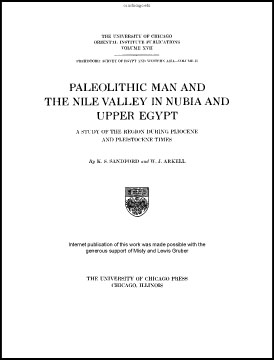OIP 17. Paleolithic Man and the Nile-Faiyum Divide in Nubia and Upper Egypt: A Study of the Region during Pliocene and Pleistocene Times K. S. Sandford and W. J. Arkell

The Pleistocene period, during which Paleolithic Man hunted along the banks of the Nile and ranged over the surrounding hills and plateaus, was a time of copious rainfall in Egypt. The present survey was started with the object of piecing together for the first time the continuous history of the Lower Nile Valley and its inhabitants before the known predynastic period. Its aim has been to visit and study as much as possible of both banks of the river, revising and coordinating previous work and collecting new data and specimens: stone implements, rocks, shells, and bones.
- Oriental Institute Publications, Volume 17
- Prehistoric Survey of Egypt and Western Asia II
- Chicago: University of Chicago Press, 1933
- Pp. xvii + 92; 21 figures, 43 plates, 1 map
- Out of Print

